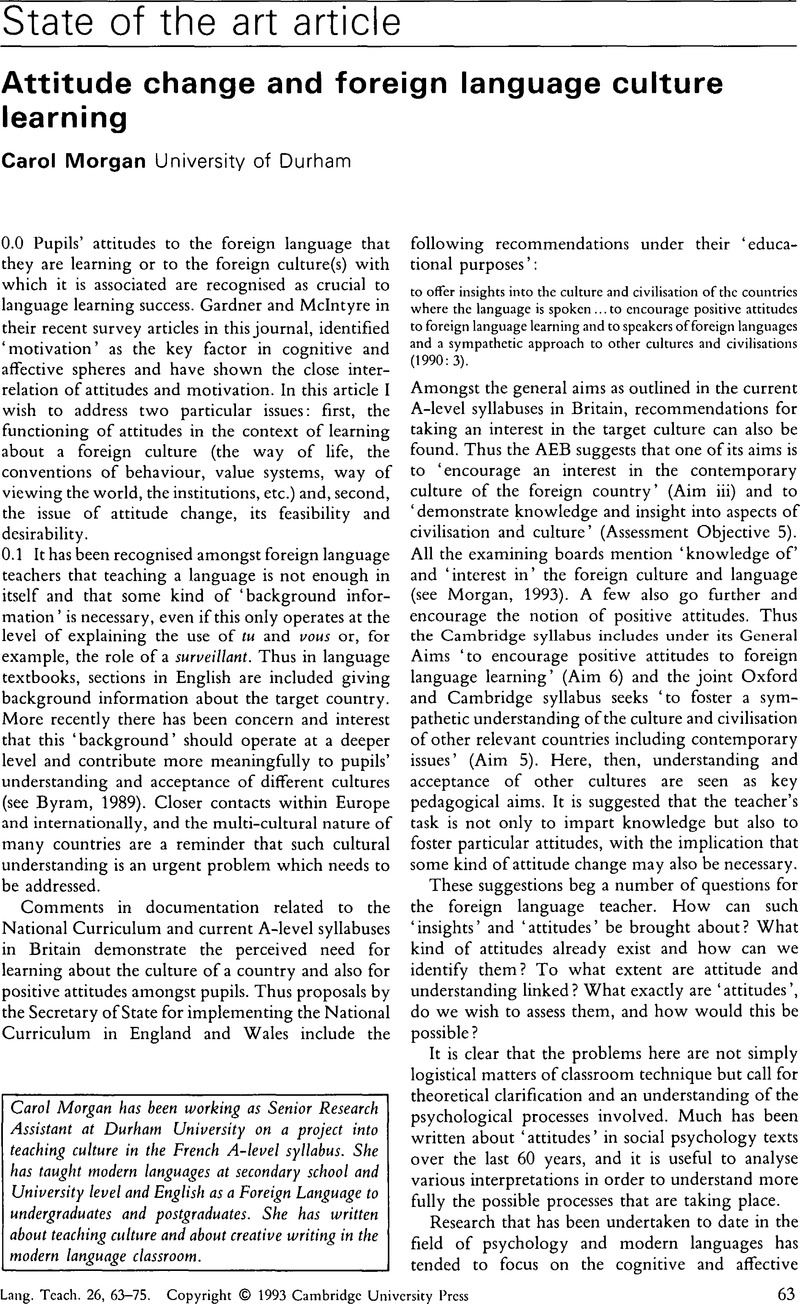Crossref Citations
This article has been cited by the following publications. This list is generated based on data provided by Crossref.
Atlan, Janet
1994.
L’approche des éléments culturels dans les publicités pour l’informatique en langue anglaise.
ASp,
Vol. 5-6,
Issue. ,
p.
171.
MANTLE‐BROMLEY, CORINNE
1995.
Positive Attitudes and Realistic Beliefs: Links to Proficiency.
The Modern Language Journal,
Vol. 79,
Issue. 3,
p.
372.
Byram, Michael
Lloyd, Kate
and
Schneider, Regine
1995.
Defining and describing ‘cultural awareness’.
The Language Learning Journal,
Vol. 12,
Issue. 1,
p.
5.
Jaszczolt, Katarzyna
1995.
Typology of contrastive studies: specialisation, progress and applications.
Language Teaching,
Vol. 28,
Issue. 1,
p.
1.
Thornton, Barbara
and
Cajkler, Wasyl
1996.
A study of year 10 student attitudes to German language and life.
The Language Learning Journal,
Vol. 14,
Issue. 1,
p.
35.
Multhaup, Uwe
1997.
Mental networks, procedural knowledge and foreign language teaching.
Language Awareness,
Vol. 6,
Issue. 2-3,
p.
75.
Coleman, James A.
1997.
Residence abroad within language study.
Language Teaching,
Vol. 30,
Issue. 1,
p.
1.
Francis, Norbert
and
Ryan, Phyllis M.
1998.
English as an International Language of Prestige: Conflicting Cultural Perspectives and Shifting Ethnolinguistic Loyalties.
Anthropology & Education Quarterly,
Vol. 29,
Issue. 1,
p.
25.
Liaw, Meei-Ling
and
Johnson, Robert J
2001.
E-mail writing as a cross-cultural learning experience.
System,
Vol. 29,
Issue. 2,
p.
235.
Lasagabaster, David
2005.
Attitudes Towards Basque, Spanish and English: An Analysis of the Most Influential Variables.
Journal of Multilingual and Multicultural Development,
Vol. 26,
Issue. 4,
p.
296.
Young, Tony Johnstone
Sachdev, Itesh
and
Seedhouse, Paul
2009.
Teaching and learning culture on English language programmes: a critical review of the recent empirical literature.
Innovation in Language Learning and Teaching,
Vol. 3,
Issue. 2,
p.
149.
Dyers, Charlyn
and
Abongdia, Jane-Francis
2010.
An exploration of the relationship between language attitudes and ideologies in a study of Francophone students of English in Cameroon.
Journal of Multilingual and Multicultural Development,
Vol. 31,
Issue. 2,
p.
119.
Finch, Andrew
2014.
Exploring EFL Fluency in Asia.
p.
59.
Vieluf, Svenja
and
Göbel, Kerstin
2019.
Making intercultural learning in EFL lessons interesting – The role of teaching processes and individual learning prerequisites and their interactions.
Teaching and Teacher Education,
Vol. 79,
Issue. ,
p.
1.
Moratinos-Johnston, Sofía
Ballester Brage, LLuís
Juan-Garau, Maria
and
Salazar-Noguera, Joana
2019.
Attitudes and motivation in English language learning amongst multilingual university students in the Balearic Islands: the effect of the L1 and other influential variables.
Journal of Multilingual and Multicultural Development,
Vol. 40,
Issue. 6,
p.
475.
Martinez, David
and
Singleton, Jenny L.
2019.
The effect of bilingualism on lexical learning and memory across two language modalities: some evidence for a domain-specific, but not general, advantage.
Journal of Cognitive Psychology,
Vol. 31,
Issue. 5-6,
p.
559.



